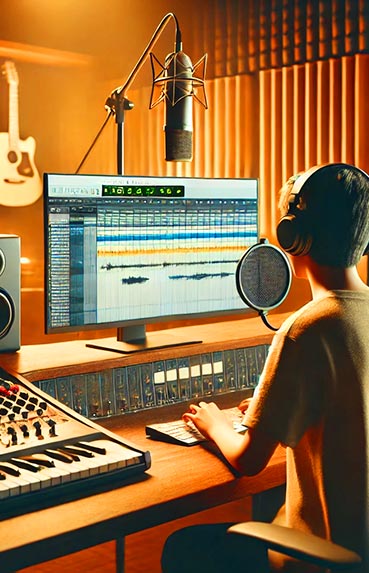In today's digital era, Artificial Intelligence (AI) has begun to play a crucial role in transforming various industries, and content creation is no exception. AI's ability to analyze data and generate automated content has revolutionized the way companies and content creators approach the production of text, audio, and video. In this article, we will explore how AI is redefining the creative process, its practical applications, and what the future holds for this technology in the realm of content generation.
AI as a Creative Tool
Automated Text Generation
One of the most prominent uses of AI in content creation is automated text generation. Tools like OpenAI's GPT-3 have proven capable of producing written content that can rival that created by humans. These tools work by analyzing large volumes of text and learning linguistic patterns that they can then replicate.
Example of use: Media companies like the Associated Press use AI algorithms to draft financial reports and sports summaries, allowing journalists to focus on more analytical tasks.
Practical tip: To maximize the effectiveness of automated text generation, it is important to provide the algorithm with clear context and specific guidelines. This may include keywords, desired tone, and content structure.
Multimedia Content Creation
AI has also made significant advancements in creating multimedia content, such as images and videos. AI tools can generate high-quality graphics and short videos based on text or audio input.
Example of use: Platforms like Canva have integrated AI features to suggest designs and color combinations, making it easier for users to create visually appealing content.
Practical tip: When using AI for visual content creation, it's helpful to clearly define brand elements, such as colors and fonts, to ensure consistency across all created pieces.
Benefits of Automation in Content Creation
Time and Resource Savings
One of the main benefits of AI in content creation is efficiency in terms of time and resources. Automation allows for the generation of large volumes of content quickly, which is especially useful for companies needing to maintain a constant presence on social media and other digital channels.
Example of use: E-commerce companies use AI to generate product descriptions, enabling them to update their catalogs quickly without relying on human writers.
Personalization and Segmentation
AI allows for unprecedented content personalization, adapting it to user preferences and behaviors. By analyzing user data, algorithms can create content that resonates with different audience segments.
Example of use: Streaming platforms like Netflix use AI to personalize content recommendations based on users' viewing history.
Practical tip: To make the most of personalization, it's crucial to have a well-structured and updated user database, which will allow AI to make more accurate recommendations.
Challenges and Ethical Considerations
Quality and Creativity
While AI can generate content quickly, quality and creativity can often be a concern. Automatically generated texts may lack nuance and originality, which could affect brand perception.
Practical tip: To maintain quality, it's advisable to combine automation with human oversight, reviewing and adjusting AI-generated content before publication.
Ethical Considerations
The use of AI in content creation raises ethical questions, such as intellectual property and authenticity. It's important for companies to be transparent about their use of automated tools and to consider the legal implications.
Example of use: Some artists and writers have expressed concern about the use of AI to create works that could infringe on copyrights or dilute the originality of human creations.
It is crucial for organizations to maintain a balance between the efficiency offered by AI and the human value in content creation, thus ensuring authenticity and integrity in their communications.
Future of AI in Content Creation
Technological Advancements
As AI technology continues to advance, we can expect improvements in the algorithms' ability to understand context and generate more coherent and relevant content. The development of more advanced AI will allow for greater integration of this technology in complex creative processes.
New Creative Opportunities
AI also opens up new possibilities for creative experimentation. For example, in the film and music industries, AI can be used to create unique scripts or musical compositions, offering creators a new tool to explore and expand their artistic boundaries.
Practical tip: Creators and companies should stay informed about the latest AI innovations and explore how these can be effectively incorporated into their creative processes to remain competitive.
Integrating AI into Content Strategies
Needs Assessment
Before implementing AI solutions, it is important to assess the specific content needs of the organization. This includes identifying which types of content could benefit from automation and which require a more personalized human approach.
Practical tip: Conducting a thorough analysis of current content creation capabilities and setting clear objectives can help determine how and where to integrate AI most effectively.
Training and Adaptation
Successful implementation of AI in content creation requires not only technology but also staff training to adapt to new tools and processes.
Example of use: Digital marketing companies are training their teams in the use of AI platforms to optimize advertising campaigns, allowing professionals to focus on strategy and results analysis.
Practical tip: Investing in continuous training programs and promoting a culture of learning within the organization will help maximize the benefits of AI in content creation.
In conclusion, AI is playing an increasingly important role in automated content creation, offering significant benefits in terms of efficiency and personalization. However, it also presents challenges that must be carefully considered to ensure a balance between technology and human creativity. As AI continues to evolve, it is essential for companies and content creators to adapt and seize the opportunities this technology offers.

















